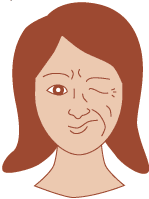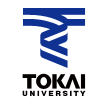- HOME
- For Patients
- Facial spasm and trigeminal neuralgia
Facial spasm and trigeminal neuralgia
- Symptoms of facial spasm and trigeminal neuralgia
- Cause of facial spasm and trigeminal neuralgia
- Diagnosis of facial spasm and trigeminal neuralgia
- Treatments of facial spasm and trigeminal neuralgia
Symptoms of facial spasm and trigeminal neuralgia
Hemifacial Spasm

Hemifacial spasm is a condition in which tics and spasms occur on one side of the face only.
It starts with tics around the eye, and after a while develops to the state where psychological tension induces uncontrollable twitching around the eye, with the eye itself becoming difficult to open, or closing of its own accord. Left untreated, the spasms eventually extend from around the eye to the cheek, pulling the mouth to one side in a characteristic set of symptoms. This disorder is particularly frequent in women, and in severe cases people may become reluctant to go out or avoid meeting other people.
(In general, although symptoms may improve temporarily, this is a progressive disorder that will not get better without treatment. It usually occurs around age 50, is rare in people under 30 years old, and is known to be 2- to 3-times more common in women than in men.)
Trigeminal Neuralgia
Trigeminal neuralgia is a condition in which a sudden sharp pain like an electric shock affects part of the face, continuing for several seconds. Symptoms frequently occur in the area between the cheek and lower jaw, meaning that people sometimes mistake the pain for toothache and go to the dentist, or visit an ear, nose and throat clinic thinking the problem is in the nose. In many cases, symptoms are induced by stimuli such as brushing the teeth, eating, face-washing, or wind blowing on the face. In addition, compressing a particular area of the face will produce the same symptoms.
(As with facial spasm, symptoms typically first appear around age 50, and the condition tends to be more common in women.
The trigeminal nerve has three main branches leading to: 1) the forehead; 2) the cheeks; and 3) the jaw. Most people with this condition complain of symptoms in the cheeks and jaw, although some experience pain across the entire face. Symptoms frequently vary, and may improve or deteriorate.)







